Numerical Beethoven
Statistics and Analysis of Beethoven Performances in 1924 Paris
Beethoven is, as many are aware, one of the most significant figures in traditional readings of Western music history. While it is easy in musicology to say that one composer or another is highly influential, that does not always correlate to being “popular” composers – that is to say, well-liked and recognized by the general public. So how do performances of Beethoven’s works in 1924 Paris match up to the composer’s influence? In simply looking at the raw numbers, it is plain to see that reverence of Beethoven was alive and well. Of the over 1,300 performances we have recorded, 123 contained at least one work by Beethoven – and 16 of those contain multiple. That means that at more than one in every eleven concerts, someone in 1924 Paris heard Beethoven – this includes not only concerts of classical music, but also many café-concerts, cabarets, music halls, and other venues that provided more popular music than art music.
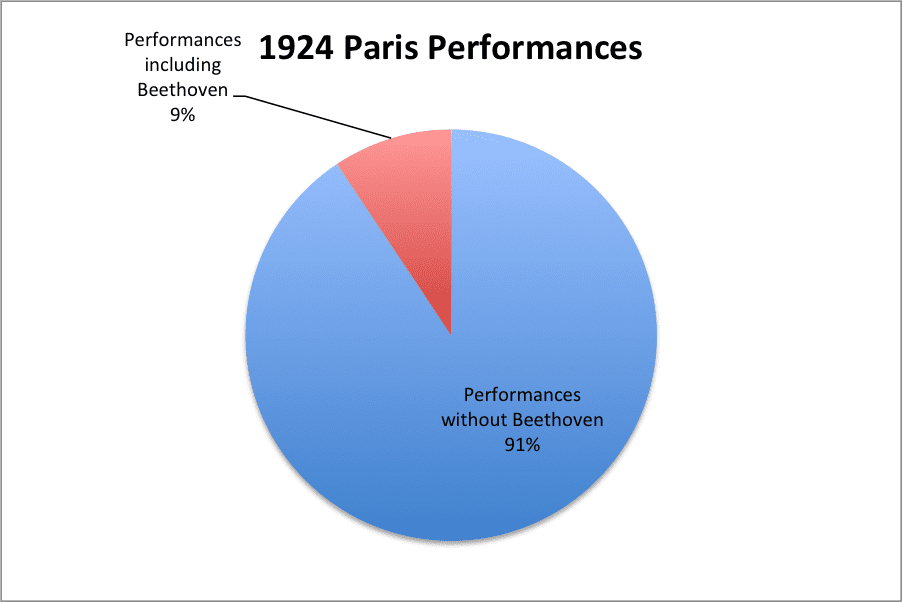
So we know that attending a random concert in 1924 Paris gives you a pretty decent chance of hearing something by Beethoven – but what exactly might that be? Unfortunately, some of the sources we have used do not give as much detail; however, many do specify what work was performed, or at least what genre of work. Some of this had to be approached in a speculative manner – for example, there may not be a program given, but the concert listing does mention that a certain (string) quartet will be playing “works by Beethoven” in a venue typically reserved for chamber music, in which case one can assume with a reasonable degree of confidence that they will be playing one or more of Beethoven’s 16 string quartets. I worked my way through every listing mentioning works by Beethoven, and grouped them into seven categories: Symphony, Overture, Sonata, Concerto, Chamber Music, Unknown, and Other (this last section contains ballet, mass, song, and solo works that do not fit elsewhere). What can be found by comparing the relative frequency of these works is fascinating. Note that this graphic shows more than 100% of all performances, as some performances contained multiple works by Beethoven of different genres.
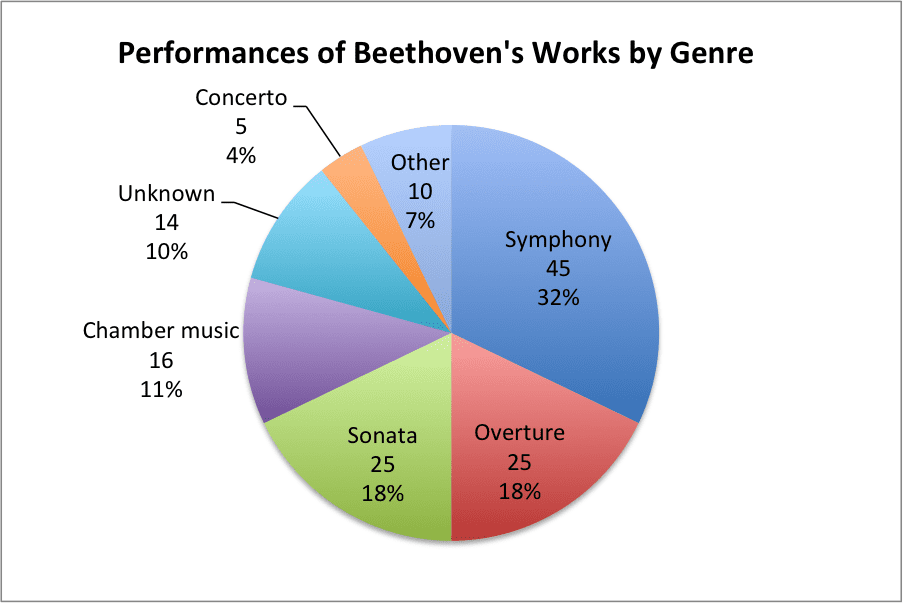
As you can see, the nine symphonies form a plurality at almost one-third of all the works by Beethoven performed. Together, full-orchestra genres (symphony, overture, and concerto) form over one-half of all works, while solo music (sonata) makes up a little under one-fifth and chamber music counts for even less, approximately 11%, or one-ninth. Even if we break up the “other” category and distribute it into these three larger categories (orchestral, solo, and chamber), orchestral works remain strongly ahead of the rest, in fact rising to just under 60%. So why is there such disproportionate representation of Beethoven’s works? To answer this question, we can take a look at who was performing these pieces.
Clocking in at an astonishing 37 performances of Beethoven’s pieces, the Concerts Touche win the gold for the pure number of programs containing Beethoven. The next-closest institution – the Concerts Colonne – only had 13 such concerts in 1924. Why such disparity? In The Harlequin Years: Music in Paris, 1917-1929, Roger Nichols classifies the Concerts Touche as one of the “lower-profile” orchestras active in Paris at the time, “which guaranteed not to offend.” Nichols points to these orchestra’s budgets, which were considerably lower than other more renowned ensembles, and implies that in order to turn a profit, they had to program differently from more established organizations. Instead of performing a mix of old and new music, these orchestras tended to give the public exactly what it wanted – old favorites, and at a reasonable price. Clearly, whoever was in charge of programming concerts for the Concerts Touche thought that Beethoven would sell tickets and fill seats, resulting in Beethoven, and particularly his works for full orchestra, flooding the musical market.
Also notable about this graph is the large number of concerts given outside the support of a large institution (or at least, without such support listed in our sources). These 29 performances consist mostly of smaller works – chamber or solo – and represent roughly 3/4 of such concerts.
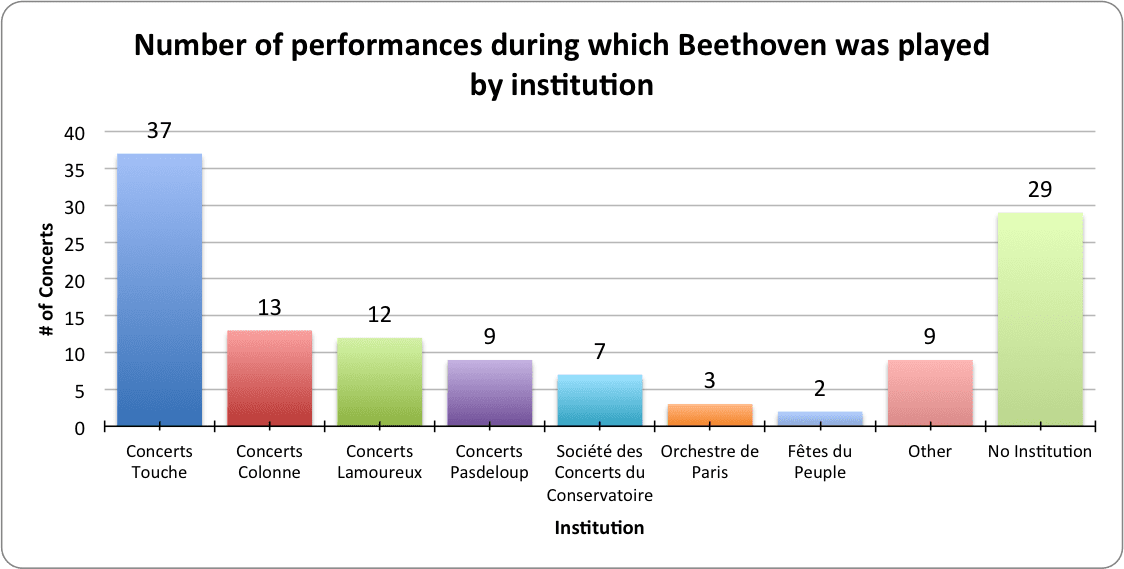
So after looking at who was playing Beethoven, where do we look next? Well, that’s exactly the question – where? This next graph displays at which venues one could most often hear pieces by Beethoven performed. It reveals a roughly similar arrangement to the graphs of institutions and genres above, because certain venues were associated with certain organizations and genres. For example, the Salle des Agriculteurs was typically host to chamber and solo music; the only full orchestras we have recorded playing there are the Orchestre de Paris and the Concerts Braïlowsky, both fairly minor ensembles. Of the twelve concerts there, they are responsible for three; the other nine are all soloists and chamber groups. On the other hand, the Salle Touche is (predictably) heavily associated with the Concerts Touche, who performed all but one of their concerts we know of there.
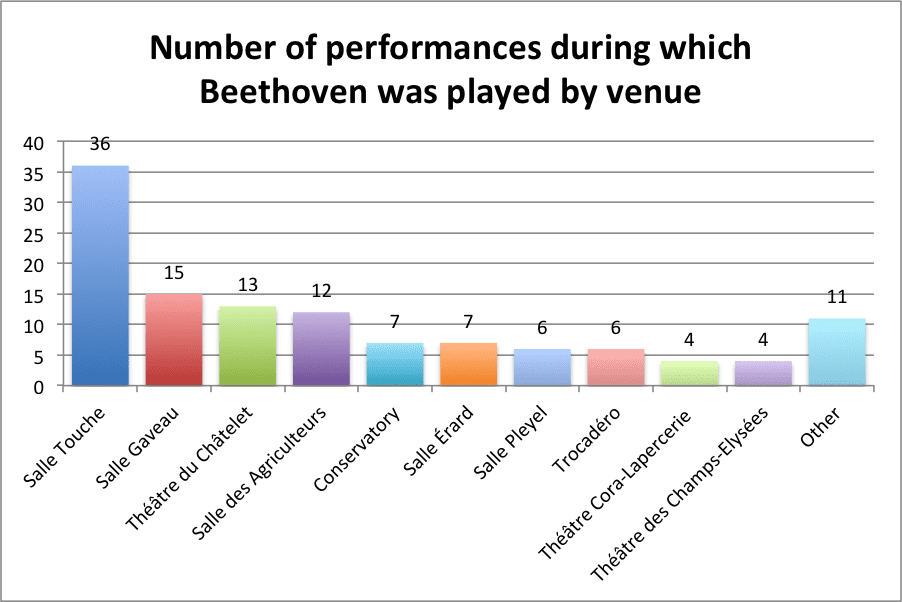
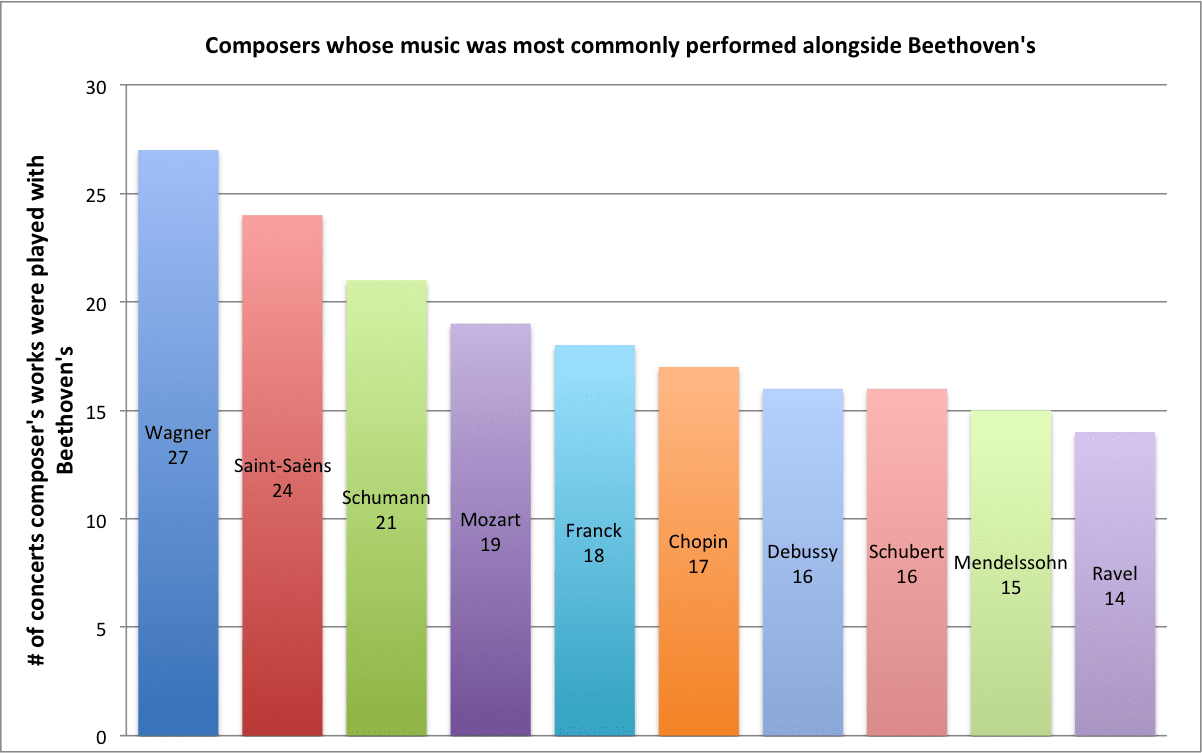
Having settled issues of which of Beethoven’s works one could hear where and performed by whom, we turn to a more internal structure – how was Beethoven programmed within a concert? Specifically, which composers had music that was performed alongside Beethoven’s? While this graph also reveals by proxy simply what other composers were particularly popular in 1924 Paris, it can also demonstrate the variety of compositions that were set to accompany old Ludwig’s. While this graph displays far from all the composers who were paired with Beethoven – all in all, we have 137 – it does show the top ten. When looking at these statistics, keep in mind that we have recordings of 123 concerts containing Beethoven. What this means, in conjunction with this graphic, is that almost 22% of Beethoven performances were accompanied by Wagner, 19.5% by Saint-Saëns, and 17% by Schumann. You can do the rest of the math yourself.
Also of note about this graph is that every composer with the exception of Ravel was deceased – the next living composer after him is Fauré at #13, who died November of 1924, followed by Louis Aubert (#24), Gustave Charpentier (#27), and Paul Dukas (#28). What this tells us is that the institutions and individuals who programmed Beethoven pieces among the repertoire they performed were less quick to program music by living composers, let alone contemporary works.
The final graph I have to share once again takes a look at the internal structure of concerts, but instead of digging into other pieces, it zeroes in on Beethoven’s. Here, you can see displayed the relative frequency of where within a given concert program a Beethoven symphony is likely to be placed. Having noticed a seeming trend among the programming of organizations that performed more familiar works, I decided to take a look at this particular statistic and found, just as was suspected, that the most common placement for a Beethoven symphony is at the very beginning of a concert. Second place is tied between – well, second place, and last. However, this is somewhat deceiving; in fact, in four of the six instances in which a Beethoven symphony is performed last, there are only two pieces on the entire concert (three of these are in a series by the Concerts Lamoureux where they performed Fauré’s Requiem followed by Beethoven’s 9th symphony; the fourth is the same program put on by the Concerts Colonne). So really, in 62.7% of cases, a Beethoven symphony was either performed as the first or second piece of a concert. This leads to the conclusion that his symphonies were used to gain attention and gather a crowd – they may have been the “main event” of a concert for some because they represented the bulk of familiar music for audiences not as well versed in the world of music, while for others they were something familiar to latch onto and train the ear to listen to what may have been somewhat less familiar music that followed. Of course, it could also be the case that the philosophy behind concert programming has changed since 1924, and Beethoven’s symphonies were placed first on the program for some other reason. After all, audiences change with time; perhaps the optimal program configuration to draw crowds has with them.
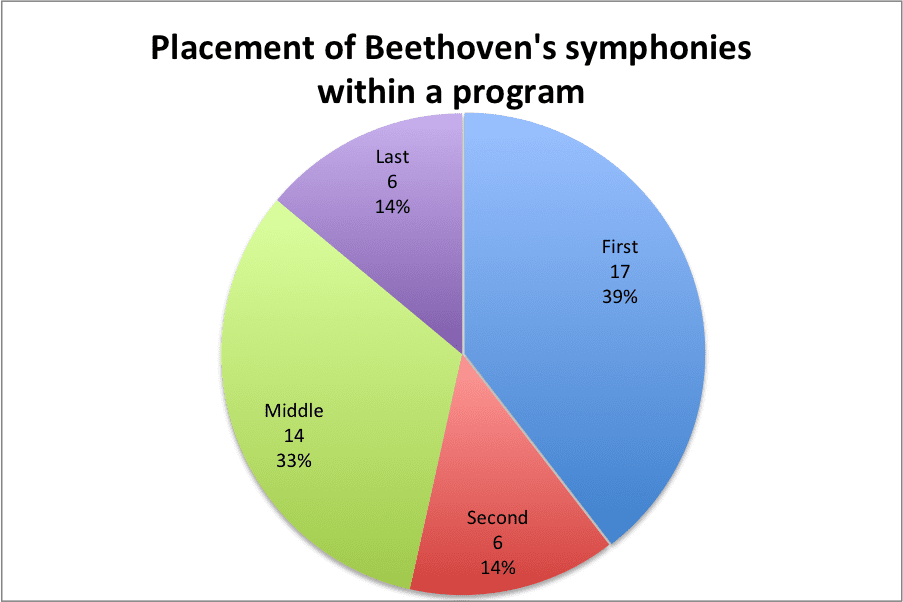
While this is far from a complete analysis of how Beethoven was venerated in 1924 Paris, it is certainly a start, and can easily be built upon by further study of the data set. Part of the purpose of this exploration is to show just how powerful and information-dense mapping music history can be; as mapping tools developed more specifically to the needs of this project and this discipline as a whole become available, further exploration and learning similar to what has been shown here (but also reaching far, far beyond it) will become possible.
If you’d like to learn more about performances of Beethoven’s work in 1924 Paris, you can explore a map of his symphonies including embedded audio of the programs as well as one of all of his works (without embedded audio).
Sources:
Nichols, Roger. The Harlequin Years: Music in Paris, 1917-1929. Berkeley: University of California Press, 2002. Print.